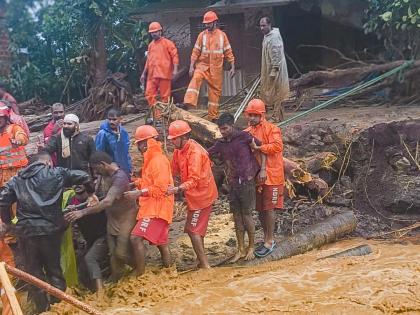Kerala Landslide: Indian Army Rescues 4 People Alive 3 Days After Major Tragedy
By Lokmat English Desk | Updated: August 2, 2024 11:57 IST2024-08-02T11:56:28+5:302024-08-02T11:57:26+5:30
In a meticulously coordinated operation, the Indian Army successfully rescued four individuals stranded in Padavetti Kunnu, Wayanad. The rescue ...

Kerala Landslide: Indian Army Rescues 4 People Alive 3 Days After Major Tragedy
In a meticulously coordinated operation, the Indian Army successfully rescued four individuals stranded in Padavetti Kunnu, Wayanad. The rescue team, comprising two males and two females, was brought to safety through a well-executed casualty evacuation mission. The operation, characterized by precision and care, involved the deployment of an Advanced Light Helicopter (ALH) to facilitate the swift evacuation of the stranded individuals. This prompt and effective response underscores the Army's commitment to ensuring the safety and well-being of those in distress.
Wayanad landslide | Indian Army found 4 alive individuals - two males and two females - who were stranded in Padavetti Kunnu, Wayanad. The operation was carried out with precision and care, ensuring the safety of all individuals involved. A casualty evacuation was coordinated and…
— ANI (@ANI) August 2, 2024
During the rescue, one of the female individuals encountered difficulty with her leg and is currently receiving necessary medical attention. Landslides in Chooralmala and Mundakkai have plunged Kerala into mourning, with the death toll now exceeding 317. Officials worry the number could climb higher, as more than 220 people remain missing. Due to relentless rainfall, rescue operations that were supposed to continue until 4 pm were cut short on Thursday.
A day after Home Minister Amit Shah criticized the Kerala government for not acting on a prior warning of a possible natural disaster, IMD chief Mrutyunjay Mohapatra clarified that an orange alert had been issued the day before the Wayanad landslide on July 29. Although the orange alert was meant to prompt preparatory actions, experts pointed out that the real issue lies in the lack of coordination among multiple agencies. Despite issuing a red alert on the morning of July 30, prior warnings of heavy rainfall could have prompted better preparedness. Mohapatra explained that the IMD had issued a yellow warning on July 25, which was upgraded to orange by July 29, and then to red on July 30, due to expected heavy rainfall.